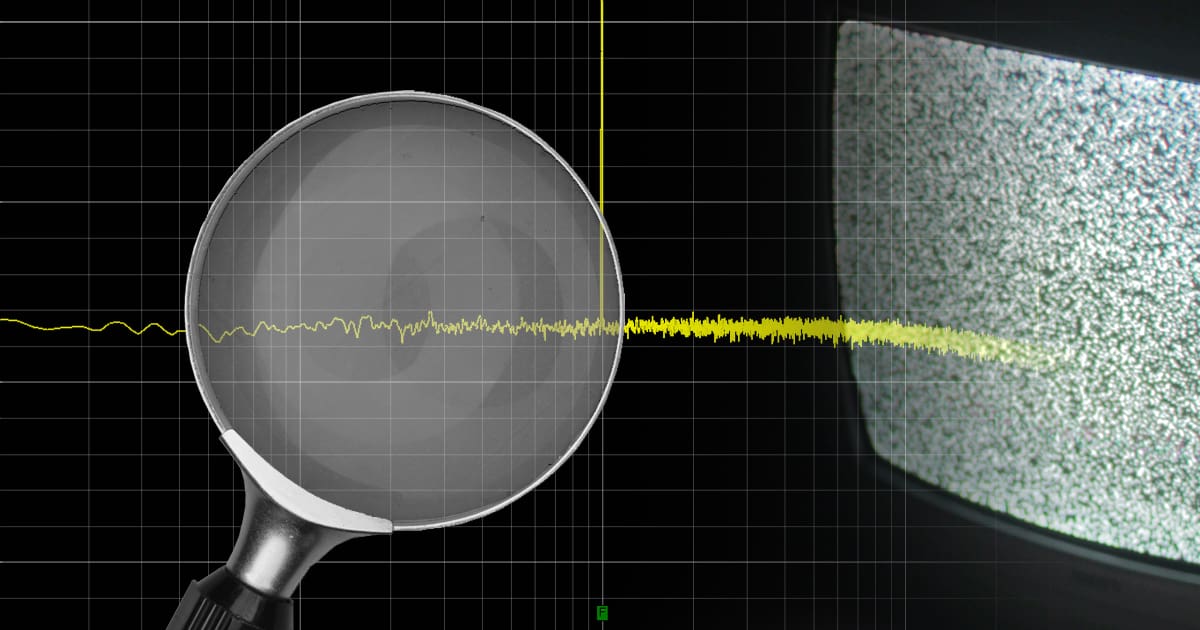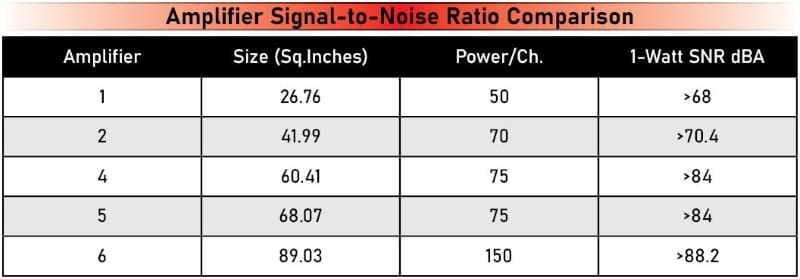Part Two of our series on the difference between car audio amplifiers will look at the topic of noise. Every amplifier, from every brand and at every price point, adds a little bit of noise to the audio signal that passes through it. Whether that noise is an issue depends on the amplifier’s design and the speakers you’re using. Let’s take a close look at noise and explain why it matters.
What Is Amplifier Noise?
If you’re old enough, you might remember when TV stations signed off at night. They’d stop broadcasting around midnight or 1 a.m., and the staff would go home. If your TV were tuned to that station after the broadcast stopped, you’d see random tiny white and black dots all over the screen and hear a hissing sound. Both the audio and video signals are noise. The same goes for a radio tuned to a frequency where no station is broadcasting. All you hear is hiss. That’s also noise.

From a technical perspective, the dictionary defines noise as irregular fluctuations that are transmitted along with a signal but are not part of the signal. Here’s where noise affects our ability to enjoy our audio systems. That noise can obscure part of the signal. If it’s high enough in amplitude, the noise can drown out the signal.
Sources of Noise in Car Audio Systems
In car audio systems, there are three common sources of noise. There may be some noise in the original recording. Most are clean these days as the equipment used downstream of the microphones is quite high quality. When vacuum tubes were all that was available to audio component designers, noise was much more prevalent.
The playback source, which is usually a radio or a source unit, is the first place that might add noise to the audio signal. To be clear, every source unit adds some noise. Whether or not you can hear it depends on the amount of noise and possibly the playback level.
Noise can also enter an audio system through wiring. For example, if speakers are connected directly to a source unit, and the wiring passes by an electric motor, that might induce some noise. Passive crossover networks near a motor or a computer module can also pick up noise.
You’re more likely to pick up noise on RCA interconnect cables running from a source unit to an amplifier. The audio signal on these cables is very low, often in the millivolt or even microvolt range, so it’s easier to impose noise that becomes audible later. To avoid this, use twisted-pair interconnects with a grounded shield and amplifiers with differential input circuitry.
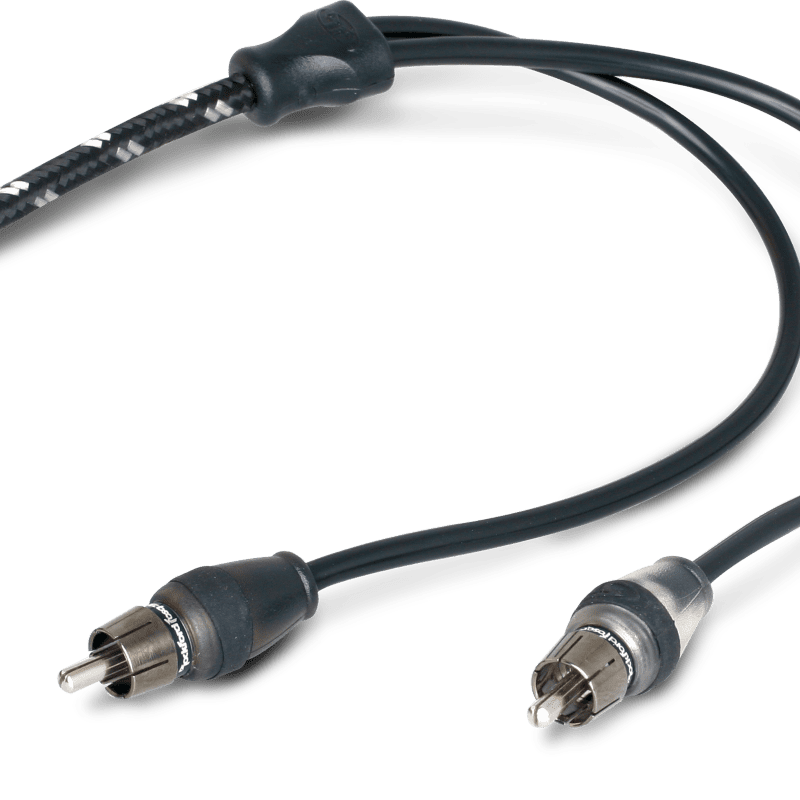
Car Audio Amplifiers as a Source of Noise
Finally, we get to our amplifiers. By their design, amplifiers take a small amplitude signal and make it louder. If a tiny amount of noise in the signal goes into an amp, that noise will increase in amplitude along with the audio signal. The more powerful the amplifier, the more gain it has, and the more it will amplify that noise.
Second, the amplifier itself will add noise. Each time the audio signal passes through a component, especially an active component like an op-amp, the device itself generates noise that’s added to the signal. While the noise specifications might be minute, the input stage of a typical car audio amplifier might have eight to ten op-amps in the signal path for each channel. The product needs more op-amps if it has crossovers, signal summing, bass boost and other functions. Each one adds a minute amount of noise. Designing this circuitry properly is crucial to making an amp that would be considered to have minimal noise.
Amplifier Layout Affects Noise
Many car audio enthusiasts don’t fully understand that the layout of an amplifier circuit board plays a significant role in the noise characteristics of an amp. The Zapco Model 150 amplifier from the mid-1970s was a perfect example of this philosophy. Robert Zeff (the Z in Zapco) knew that power supplies were noisy. As such, he mounted it in a separate chassis from the audio amplification stage of the Model 150 amp. This simple decision helped keep high-frequency switching noise away from the audio signal and made the amplifier quieter in terms of noise.
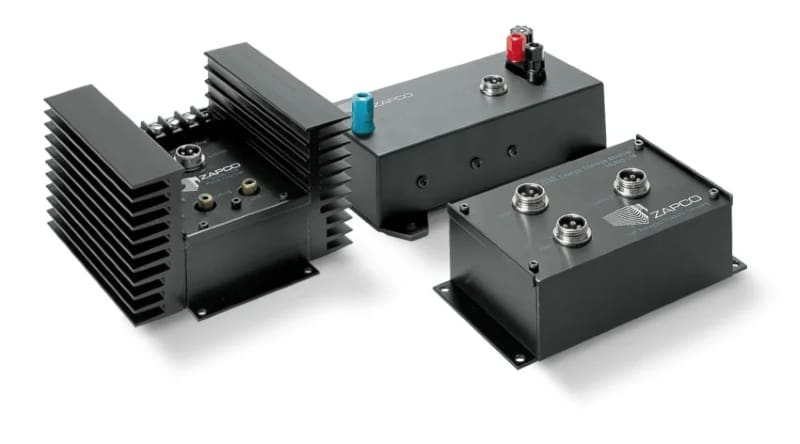
In modern amplifiers, the physical location of power supply components on the circuit board plays a role in how much noise leaks or is transposed onto the audio signal. Amplifiers in a small chassis often have worse noise performance than physically larger solutions.
How We Measure Amplifier Noise
The standard for measuring the noise added by an amplifier is called the signal-to-noise ratio. When we test an amplifier for noise performance, we feed a test tone into the amp and then measure the amplitude of the noise around the tone relative to the amplitude of the tone.
As per the ANSI/CTA-2006-D standard, the reference for car audio noise measurement is to set the output level of a test tone to 1 watt into a 4-ohm load. One watt of power is 2 volts when driving a 4-ohm speaker. Then, measure the level of the noise around that test tone. This process is nearly impossible to perform manually, so hardware like an Audio Precision or QuantAsylum analyzer simplifies the process.
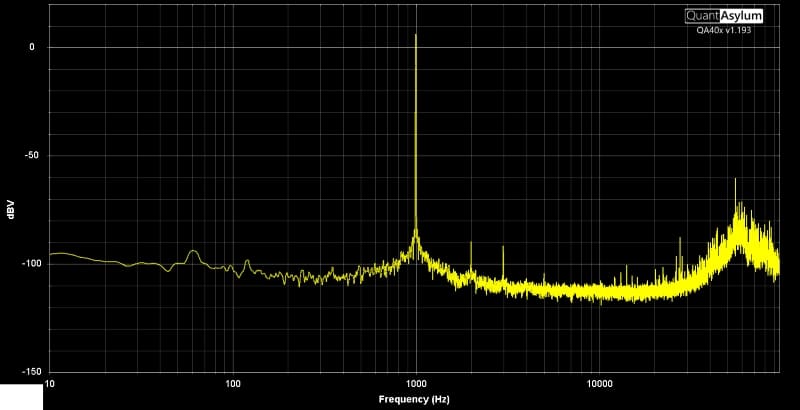
In the above chart, we can see the 1 kHz test tone at a level of 2.000 V as the tall yellow peak in the middle of the graph. The QuantAsylum software analyzes the noise amplitude (represented by the squiggly horizontal line) between 20 Hz and 20 kHz and determines its amplitude. In this case, the noise is 81.8 dB below the amplitude of the test signal. This is an ARC Audio Nighthawk amplifier, and the 81.8 dB is a good noise measurement.
High Quality Amplifier Performance
What about a large amplifier with a power supply 10 inches away from the audio input stage? For many years, the ARC Audio SE2300 has been our reference amp for speaker listening evaluation in the lab. Here’s the spectral analysis of the SE2300 playing a 2.0-volt, 1 kHz test tone.
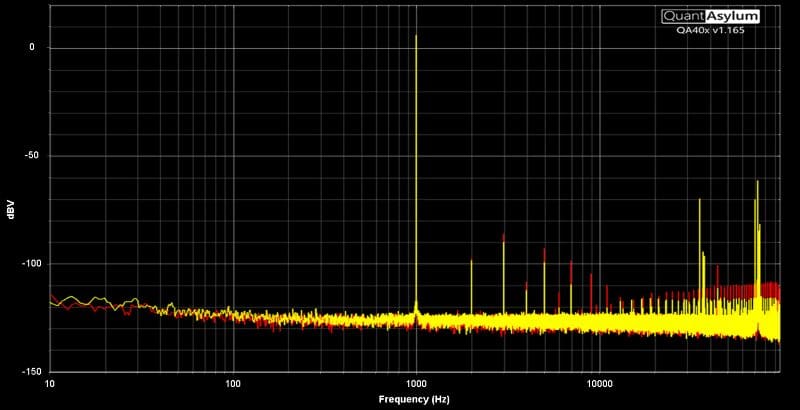
As you can see, the background noise is almost 20 dB lower. You can’t hear any noise from the Nighthawk unless you put your ear against a tweeter. The SE2300 would produce about 20 dB less noise at those frequencies. By way of a ratio, 20 dB is 100 times less noise.
Here’s an example of an amplifier that’s somewhat noisy. It’s a compact amp, meaning its footprint is about 2.5 by 7 inches. The small physical size puts the power supply very close to the audio signal circuitry. We should be clear: While this is noisier, it’s not an outright disaster. You can barely hear the hiss in a standard vehicle without using crazy-efficient tweeters.
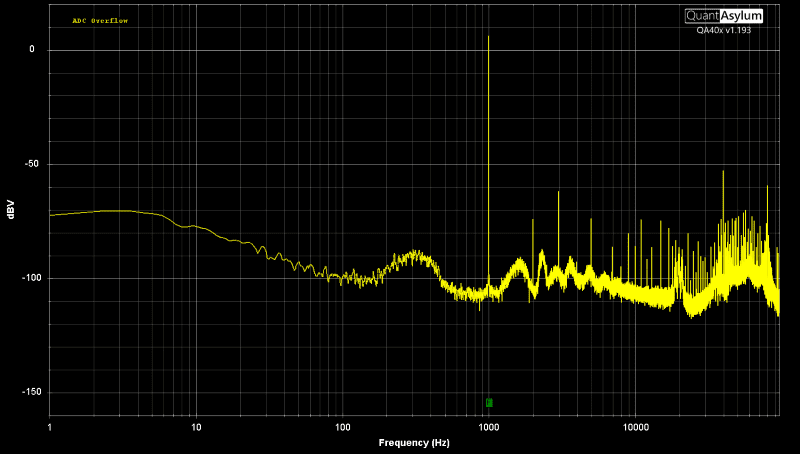
Noise Versus Amplifier Size
The chart below compares the published signal-to-noise ratio of six different amplifiers, all from the same company. We determined the amplifier size by multiplying the width by the depth of the amp to calculate its footprint. The next column is the rated power production capability of the amp in watts per channel into 4-ohm loads. These are all four-channel amplifiers. Finally, we have the published A-weighted signal-to-noise ratio measurements. You can see clearly that the smaller amplifiers add more noise to the signal even though they have less gain since they produce less power.
Why Does Noise Matter?
Whether or not noise matters depends on where and when it enters the signal chain and how much there is. Amplifiers that are capable of producing large amounts of power have more gain. That’s how they work. So, if there is noise on the signal coming into the amp, that noise will be louder on the signal going to a speaker or tweeter. A low-quality source unit with a great big amplifier and super-efficient tweeters is a recipe for a system with a lot of noise. Yes, I’m looking at you, bass heads and motorcycle guys.
You can perform a test to demonstrate how noise affects your listening experience. Sit in your living room, bedroom or den and turn on the TV, the stereo or even a smart speaker. Now, set the volume quite low. You want to be able to hear everything, but you should have to concentrate to hear the music.
A Simple Noise Demonstration
Now, turn on a fan. Any table or free-standing fan will work. Maybe not a ceiling fan, as they’re typically pretty quiet unless you have them cranked. Now, try to listen to the music. Listen to a few songs and pick out the soft or quiet parts.
Now, turn off the fan. That dramatic improvement in your ability to hear what the speaker(s) reproduces is from an improvement in the signal-to-noise ratio in the room. The fan’s noise drowned out the music from the TV or speaker. You can repeat this by placing the fan beside you so it’s louder, then watch TV or listen to music at an average volume level. Turn the fan off again to see how much easier it is to hear what you want.
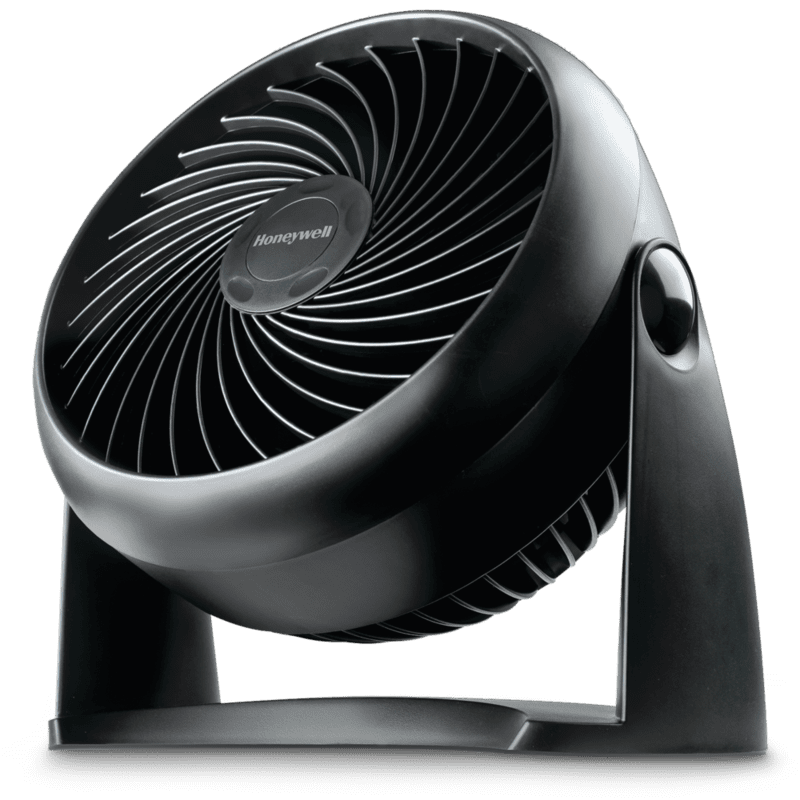
We admit that this example is more dramatic than a great amplifier versus a poorly designed noisy one. A high noise floor is sometimes only audible in the silence between songs. Nobody would want more noise, so looking for amplifiers that produce enough power for your application (not 400 watts to a set of tweeters), have good signal-to-noise ratio specifications, and are correctly installed are good steps to ensuring that there isn’t anything detracting from your listening experience.
Noise-Free Amplifiers Sound Better
Drop by a local specialty mobile enhancement retailer today and audition the amplifiers on their displays and in their demo vehicles. Listen to the noise the system produces between tracks or when the volume level is low. If it’s audible, something in the signal chain is adding a lot of noise or the system isn’t configured correctly. Keep searching until you find a suitable solution so you can get all the enjoyment possible from your favorite music.
When it’s time to buy a new amplifier for your car or truck, drop by a local specialty mobile electronics retailer and audition the solutions they offer. Listen carefully to the tweeters in the demo system to see if there is any hiss or unwanted static.
More From Our “Amplifier Differences” Series
- Part 1: Frequency Response explores how amplifiers handle different frequencies and how this affects the sound. It discusses the ideal of uniform amplification across all frequencies and examines how real-world amplifiers compare, using specific models for illustration.
- Part 2: Noise delves into the noise that amplifiers can add to the audio signal, how it’s measured, and its impact on sound quality. It explains the signal-to-noise ratio and how different amplifiers manage noise, including the effect of amplifier size on noise performance.
- Part 3: Harmonic Distortion discusses the concept of harmonic distortion, how it affects sound quality, and the performance of different amplifiers in minimizing it. It also touches on the distinction between even- and odd-order harmonics.
- Part 4: Distortion Versus Power Level and Frequency examines how distortion levels in amplifiers change with power levels and frequencies, highlighting the differences between high-quality and low-quality amplifiers in handling distortion.
- Part 5: Intermodulation Distortion focuses on intermodulation distortion, how it’s measured, and its effect on sound quality. It contrasts the performance of different amplifiers in managing IMD.
- Part 6: Car Audio Amplifier Crosstalk addresses how crosstalk between channels in an amplifier can affect the stereo imaging and soundstage of car audio systems, impacting the overall listening experience.
